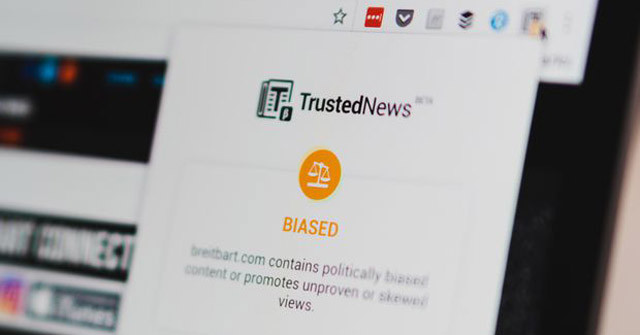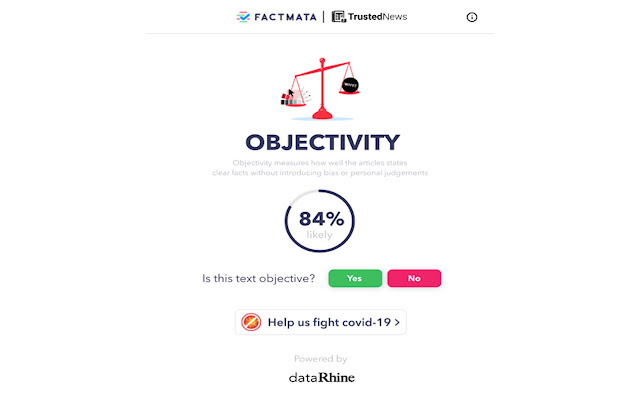How One Browser Extension Raises a Sword Against Fake News

Identifying media biases as a corrosive influence on the consumer, the browser extension TrustedNews aims to fight it at the point of delivery.
TrustedNews was created in 2018 by eyeo, the German company behind Adblock Plus. The Chrome browser extension affords an instant and intelligent analysis of a news article’s objectivity. Users receive this information as a percentage visual – a ‘nutritional value’ for news. The extension was initially powered by Metacert Protoco — a blockchain-based online protocol. It calculated ratings by aggregating trust data from ostensibly independent sources, such as PolitiFact, Snopes and Wikipedia.
Since its rollout, TrustedNews has changed somewhat. The AI software company Factmata assumed development of the browser in 2019, with investment from eyeo — beginning a shift towards machine learning to better scan content for bias. This system is trained by data science experts at DataRhine, and analyses every sentence individually, before giving an overall, normalised score out of 100. In the future, TrustedNews hopes to improve this interface by classifying articles into categories like propaganda, clickbait, etc.

Media bias – real or perceived?
For a new media object like TrustedNews to be valuable, it must solve a credible issue. Earlier this year, a detailed paper by Gallup and the Knight Foundation found that a majority of Americans feel a ‘great deal’ (49%) or a ‘fair amount’ (37%) of political bias in news coverage. Certainly, the homogenising effects of the modern newsroom (Christin 2020), combined with the economic pressure of falling revenue could explain why newspapers might gratify the political bias of their core readership — but does this reflect reality?
Here we must make a careful distinction between false (or ‘fake’) news and biased news. Pizzagate, for example, is a prize example of false news. It found traction in low-grade, conspiracy-friendly publications only, and can be objectively (and quickly) debunked. But for a browser extension to detect bias in elite media entails a discussion on whether this bias exists, to what extent and where.
Allegations of media bias are not new. Back in 2003, academic analysis of newspaper articles could not substantiate claims of a liberal media bias (Niven 2003). And recently, one weighty contribution to this discussion bears the strongly worded title of There is no liberal media bias in which news stories political journalists choose to cover by Hassell, Holbein and Miles. Here, a combination of research methods lead the authors to the clear conclusion that whilst most journalists lie far left of the ordinary public, this evidentially doesn’t produce selection bias. Coverage alone, however, doesn’t sink an allegation of bias. A newspaper can, for example, report a story to present a veneer of objectivity, but bury it in their algorithms to kill its visibility and traction.
So what’s happening here? Watts, Dom, Shah and Fan (1999) argue that perceived media bias is created and reinforced by the repetition of allegations that such a bias exists, rather than actual biased coverage itself. It also seems to be a partisan issue, rather than one of general political extremism: radical leftists report having faith in the media, whereas media bias is perceived strongest by the radical right (Eberl 2019).
In any case, TrustedNews could offer a valuable, outlet-agnostic proposition. Its AI software privileges the language and semantic markers of the article text, rather than the editorial stance of the outlet itself. Dhruv Gulati, founder of Factmata, expands: “Most browser tools before this rely on understanding the website, rather than the article itself… This leads to inherent judgement bias…..we judge writers for what they write, not who they are.”
Can TrustedNews tackle presentation bias?
I believe the issue of media bias manifests more at the presentation level. One robust example is the 2019 Lincoln Memorial confrontation, where a video depicting a stand-off between a Native Indian man and a boy wearing a MAGA hat triggered a media storm. When full details of the incident — namely the facts ‘outside the video’ — came to light, these painted a different reality. The boy involved, who was harassed as a result of the attention, later filed defamation suits against CNN and the Washington Post, who both settled for an undisclosed amount, as well as redacting their earlier articles.
But the pertinent question is how a browser extension could address this. Advanced AI software could, theoretically, employ speech-to-text software to scan the transcript of a video, but this would prove useless for an incomplete video. It cannot analyse what isn’t there. Similarly, how could you train AI to debunk objectively written content about a misleadingly edited video? With the rise of video articles and citizen journalism, this could become a heavy roadblock for TrustedNews.

Indeed, tackling media bias of this magnitude would involve a structural reform of news practice, to compel outlets to wait for full facts before covering an event. But this would go against the immediacy of today’s news culture. Benjamin Radford highlights the paradox arising when the public understands that quality journalism often involves not reporting a story before facts are verified, but at the same time expects instant reporting on breaking events.
TrustedNews, however, remains measured in the scope of their solution. Till Faida, CEO of eyeo, explained: “First, it is a solution for users, not an ambitious plan to reform platforms or information sources”. Indeed, while it won’t change the tides of political discourse, nor replace critical thinking ‘outside the article’, it still affords the reader a handy preliminary tool.
Bibliography and Sources
Sawers, Paul. “Adblock Plus owner Eyeo launches browser extension to combat fake news.” VentureBeat. 13 June 2018.
Author Unknown. “eyeo Takes Aim at Fake News With Launch of Privacy-Friendly ‘Trusted News’ Browser Extension.” Business Wire. 13 June 2018.
Gallup/Knight Foundation. “AMERICAN VIEWS 2020: TRUST, MEDIA AND DEMOCRACY.” p2. 2020.
Christin, Angèle. “What Data Can Do: A Typology of Mechanisms International Journal of Communication 14”. p1125-1126. 2020.
McLennan, David. Miles, Jack. “A once unimaginable scenario: No more newspapers“. Washington Post. 21 March 2018.
Niven, David. “Objective Evidence on Media Bias: Newspaper Coverage of Congressional Party Switchers”. p321. 01 June 2003.
Hassell, Hans J.G. Holbein, John B. Miles, Matthew R. ” There is no liberal media bias in which news stories political journalists choose to cover”. p5-6. Science Advances. April 2020.
Watts, Mark D. Domke, David. Shah, Dhavan V. Fan, David P. “Elite cues and media bias in presidential campaign”. p144. April 1999.
Eberl, Jakob-Moritz. “Lying press: Three levels of perceived media bias and their relationship with political preferences”. p18. March 2018.
Radford, Benjamin. “‘Why Isn’t The Media Covering This Story?’—Or Are They?” Center for Inquiry. 09 November 2018.